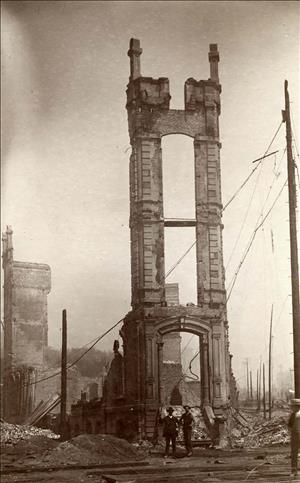Early buildings in what is now the state of Washington were mostly constructed of wood. There were no organized fire departments and not much water that could be used in the event of fire. Seattle's downtown was nearly completely burned to the ground in 1889. Many other towns also suffered terrible fires around that time. These disasters led to improvements in fire prevention and firefighting. (This essay was written for students in third and fourth grade who are studying Washington State History and for all beginning readers who want to learn more about Washington. It is one of a set of essays called HistoryLink Elementary, all based on existing HistoryLink essays.)
Fire! Fire! Fire!
Settlers chose the Pacific Northwest because of the available land and the many valuable natural resources. The forests, filled with strong straight trees, were very important to early pioneers. After clearing the land, they used pine, fir, and cedar trees to construct homes and businesses. They built sawmills and sold the extra lumber to other growing cities and towns. At this time in Washington history, these early settlements consisted almost entirely of structures built of wood. Most of the towns had fire departments made up only of volunteers, and water supplies were limited. So there was always a high danger of fire.
On June 6, 1889, a strong wind was blowing from the north in downtown Seattle. There had been little rainfall that spring, so everything was dry. It was also very hot. John E. Back was a 24 year-old Swedish immigrant who had lived in Seattle for only one year. He was lucky to find a job at the Clairmont and Company cabinet shop, which was located in the basement of the Pontius Building. He worked there with five other men.
Early that afternoon, Beck filled a pot with pieces of glue and placed it on the stove to warm. At around 2:45 p.m., the glue started to boil. Suddenly, it burst into flames. Beck grabbed a pail of water and threw it on the burning pot of glue. Instead of putting the fire out, the water caused the flaming glue to splatter. Flames spread to wood shavings on the floor. Within minutes, the whole shop was on fire. Beck and the other men realized it was out of control and ran to sound the alarm.
The fire spread quickly from building to building. The volunteer fire department arrived but did not have enough men, equipment, or water to stop the flames. By the next morning, 29 square city blocks were destroyed -- nearly the whole business district. The fire had burned all night and put itself out only when it reached the tide flats south of where Safeco Field is now located. Most of the structures that burned to the ground were made of wood. But the fire was so hot that 10 brick buildings were also destroyed. Not one human life was lost in the disaster. However, newspapers reported that one horse and as many as a million rats died in the fire. This event became known as the Great Fire of Seattle.
There are many historical photographs that show what Seattle's downtown looked like after the fire. Luckily for historians, William Boyd owned a photography studio a few blocks from where the fire started. He rushed to the scene and quickly took photographs. One shows a large cloud of smoke and crowds of people who had gathered to watch. These photos are important because they are the only ones known to exist of the fire in progress. Sadly, while he was preserving history, Boyd's studio was lost to the flames.
The day after the fire, the citizens of Seattle held a meeting. They wanted to rebuild the business district as soon as possible. But they asked Mayor Robert Moran to require that the new buildings be built of "fireproof" brick. They wanted wider streets and funding for a city-owned water system. They also wanted an organized Fire Department -- not just a group made up of volunteers. Within two months, the Seattle Fire Department was established. And during the first year after the fire, 150 brick buildings were built.
Seattle's downtown Pioneer Square is a result of the rebuilding after the Great Fire. A bronze plaque is attached to the corner of the Old Federal Building and marks the location where the Great Fire of Seattle started.
The same problems that caused Seattle's terrible fire existed in other Washington cities. Between 1882 and 1928, business districts in 20 towns across the state were destroyed by fires.

